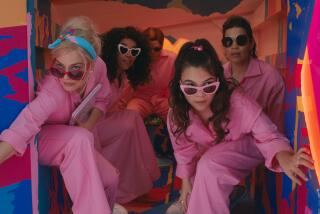Op-Ed: A hundred years ago, one Hollywood studio was a great, safe place for a woman to work
Imagine a movie industry where women write half the films, where renowned female directors are the rule and where casting couches aren’t a fixture in the boss’ office. It’s not a futuristic fantasy but a world that existed 100 years ago, when Carl Laemmle’s Universal Studios made feminist history.
Laemmle was a rebel producer in New York City who fought Thomas Edison’s monopoly on moving pictures. He owned a string of nickelodeons and charged immigrants a few pennies to see one-reel films. Nickelodeons were such a booming business that Laemmle desperately needed product to fill his theaters. He called his first company Independent Moving Pictures; when he consolidated with other rebels, he renamed it Universal.
In 1912, Universal moved from the East Coast to the West Coast, with Laemmle finally settling on 230 acres in the isolated San Fernando Valley. Business was good but not great. He didn’t have enough directors under contract to make as many films as he needed, and he didn’t want to add expensive new talent to the payroll. So he gave workers already on his lot — including actresses, seamstresses, costume designers and other female employees — a crack at writing and directing short reels and feature-length movies.
If you were female, Universal was Shangri-La.
Laemmle “startled” the other alpha moguls by commissioning women to direct, according to his biographer. Among the first to answer the call was the impish actress Cleo Madison. As she later told the trades: “I had seen men with less brains than I had getting away with it and knew I could direct, too.” She started making films about women working in dirty factories and fomenting labor unrest. Several of her films, such as “Her Defiance” (1916), did well both critically and commercially.
Lois Weber, often called America’s first female director, produced and directed a slew of films for Laemmle, many about controversial women’s issues such as abortion, divorce and sexual freedom. Her work was so popular that she became the highest-paid director at the studio and directed 100 films. Weber hired an assistant, Frances Marion, whose scripts were so good that Mary Pickford chose her as her official scriptwriter. Marion finished her career with 130 scripts to her name.
If you were female, Universal was Shangri-La. The studio was self-contained and miles outside Los Angeles, far from the influence of other studios. Laemmle built sound stages and dressing rooms, but he also built a reservoir, hospital, firehouse and sawmills. His “city” was famous for its Universal Women, who had opportunities to take on many jobs there.
In 1919, Laemmle paid one of his actresses, Laura Oakley, who was also an opera singer, to be chief of police for Universal City. The strapping Oakley took on the additional job of interviewing aspiring actresses who streamed onto the lot every week, willing to do anything to become a star. If they didn’t demonstrate their talent and diligence within two weeks, Oakley sent them packing. No sofa necessary.
Laemmle — known as Uncle Carl — treated his employees like family (and he hired family as well). His instinct for inclusivity, and its business uses, had shown up as early as 1910. He was among the first to give silent film actors star billing, including Pickford and Florence Lawrence, increasing their earning power. When top actresses, such as Lawrence, wanted more autonomy, he helped finance their production companies.
There is this telling statistic about Uncle Carl’s company: During the heyday of Universal’s silent era, there were 30 female directors and 45 busy female screenwriters on the studio payroll, arguably the most in history.
Then came “progress.” The invention of talkies lifted movies to a whole new experience and, by 1930, silent films were dead. Adding sound to movies required expensive equipment and large infusions of cash. Wall Street financiers such as Joseph P. Kennedy and Kuhn & Loeb invested in the business. They demanded more bankability and less risk, which translated into fewer opportunities for women. Soon, the Universal Women couldn’t help but see that mistresses outnumbered female directors on the lot. By the 1950s, Marilyn Monroe compared the film business “to an overcrowded brothel, a merry-go-round with beds for horses.”
Sixty years later, the situation hasn’t much improved. The sexual harassment revelations of the last few weeks are one signal. Here’s another: A recent study from USC Annenberg School for Communication and Journalism found that of the 100 top-grossing movies released last year, only five were directed by women. Men received about 87% of the screenwriter credits, women 13%. That’s a shameful statistic considering that half of the films copyrighted between 1910 and 1925 were written by women.
As director Ida May Park, another of the Universal Women, remarked in 1920, “Films are made for women, [who] compose the large majority of our fans.” That’s true today, when females make up 52% of the moviegoing audience. Yet filmmaking is top-heavy with male-driven stories, written, directed and produced primarily by men. Surely the mismatch has a role in the drop in box office receipts at movie theaters.
Here’s a case where going backward can show us how to move forward. Until women are once again directing, writing and producing the same number of films as men, and until they’re earning the same salaries, Hollywood’s power imbalance — and its sexual predator problems — won’t be solved.
Journalist and film producer Kathleen Sharp is the author of, among other books, “Mr. and Mrs. Hollywood: Edie and Lew Wasserman and Their Entertainment Empire,” which will be reissued in paperback Dec. 5.
Follow the Opinion section on Twitter @latimesopinionand Facebook
More to Read
A cure for the common opinion
Get thought-provoking perspectives with our weekly newsletter.
You may occasionally receive promotional content from the Los Angeles Times.










